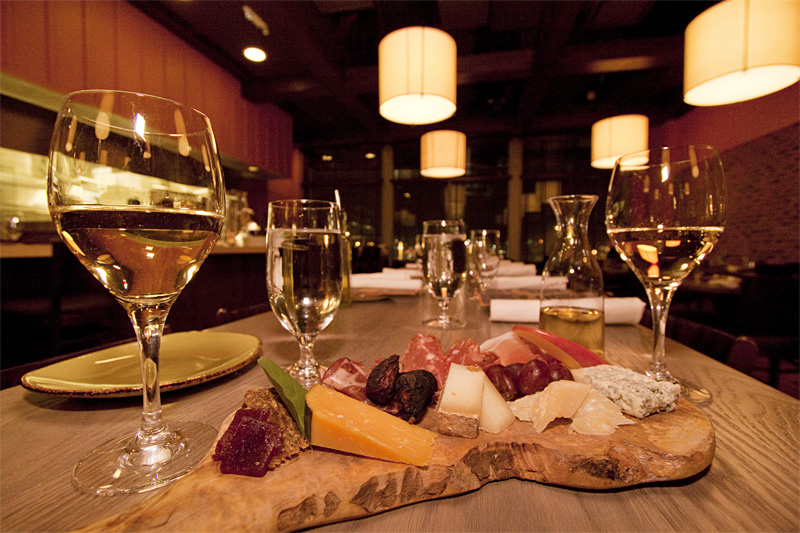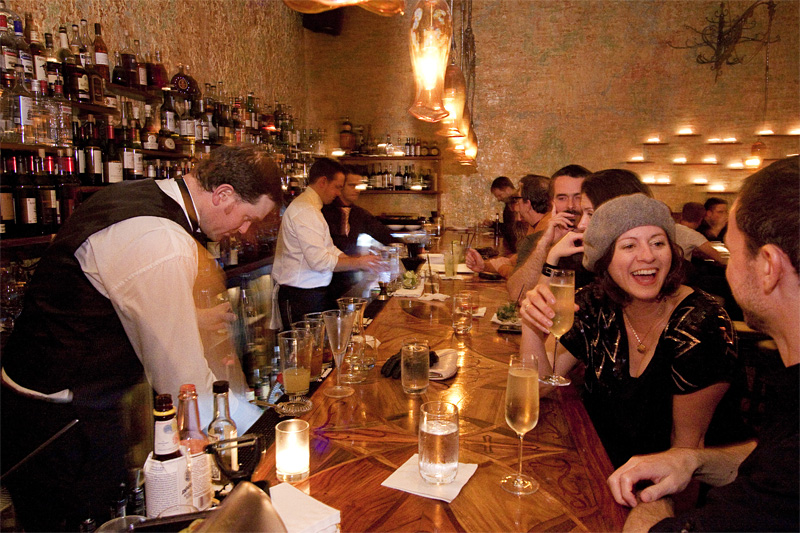Even before my review of John Howie Steak came out three weeks ago, it was back to the Bravern again. Once more into the Microsoft tower’s garage, patting the flanks of my swaybacked Honda to put her at ease amid all the Lexus SUVs and Priuses. Once more up the elevators to the Hermès level of Bellevue’s new luxury work/live/shop complex. Once more through the same doors as the steakhouse I’d just finished writing about.
But this time I scuttled around the other side of the entryway. My destination was the restaurant across the hall, Artisanal Table, which opened on the same mid-September day as its pricey neighbor. It was a slow month for restaurant openings in Seattle proper, and there was an honest-to-goodness celebrity chef from Manhattan to check out.
Terrance Brennan, whose Picholine and Artisanal Bistro have earned multiple stars from The New York Times, made Puget Sound his first stop in a Manifest Destiny–style brand expansion, simultaneously opening Artisanal Brasserie next door. I looked in at the grandly Francophile brasserie—its dizzyingly tiled black-and-white floor, its caned chairs and potted palms, its stately bar and train-station clock, its expansive, desolate dining room. I thought about how much it resembled Bastille, which had opened in Ballard a few months before.
Then I walked next door.
Julie and Julia may have given classic French cuisine like the brasserie’s a bump in popularity this year, but I thought Artisanal Table offered downtown Bellevue something more useful: an attractive wine bar with Mediterranean-themed small plates, featuring the same ambitious cheese program that made Brennan’s New York restaurant of the same name distinctive. Even though it’s less grand than its bigger sister, Artisanal Table feels more urbane; autumnal in its tones, the room is lit by paper-wrapped pendants the size of semi tires and by the freewayscape that flares and swirls through the panoramic windows at the far end of the room.
The long wooden tables at the center of the dining area are the perfect scale for the large groups of office workers who gather over bottles of wine, swirling their hair and their goblets at the same time, while couples and threesomes occupy the cafe tables and bar stools around the edges of the room. A hand-pulled espresso machine hisses at one end of the open kitchen, while a quartet of cooks twists and dips at the other.
The centerpiece of Artisanal Table’s menu is pizza, flanked on either fold by cheeses, salads, small plates, and pastas. It’s a well-designed bill of fare made for picking and drinking with business pals or friends from the golf course. Call it Banana Republic casual—and call it disappointingly uneven.
On my first visit, the pizza turned out to be the least interesting part of the meal. The pallid, black-spotted crust blistered before it browned, and the thinly sliced duck gizzards, fried egg, and shaved red peppers covering its surface overwhelmed the flavor of the sexpot ingredient: cubes of foie gras terrine. Everything surrounding it on the table, however, was uniformly great: the glass of citrus-tinged Lugana, a northern Italian white; the balsamic-bright spoonfuls of caponata, its eggplant, peppers, and tomatoes melting together into a silky, chunky spread; thumbnail-sized florets of roasted cauliflower, sweetened with golden raisins and pine nuts; dense veal meatballs stewed in a chunky tomato sauce, whose surprising resonance echoed through our palates like a bass aria in a cathedral.
In light of all this, the flubbed pizza felt like a minor error. But the truly off note was the service—not the standard procession of questions and deliveries, which were perfunctory and correct, but the element I was most looking forward to, the cheese service. The sight that had me rubbernecking in my rapid tour through the brasserie was its baronial display of cheeses, from giant gold wheels to white-rimmed puddles. Next door, Artisanal Table lists 10 of them on its menu, sold in approximately two-ounce pieces—and I was delighted to find I didn’t recognize half of the names.
So I told the waiter I’d love to try some unfamiliar cheeses. “What’s sottocenere?” I said, pointing to one name on the list.
“It’s a soft cheese,” he replied.
Me: “How about this?”
Him: “Uh, it’s another soft cheese.”
Me: “What’s the difference?”
Him: “Uh.”
Me: “Are these cheeses cow, goat, or sheep’s milk?”
Him: “Definitely cow.”
Me: “How about the difference between this robiola due latti and this robiola rocchetta?”
Him: [More stuttering.]
By the time the waiter started describing gorgonzola to me—even Paula Deen cooks with gorgonzola—and I cut him off, the mutual frustration was apparent. Finally, he offered to have the cheese steward pick out a couple for me. I gave him a few specs (one mild and creamy, one really pungent), and he returned with two unctuously ripe, beautifully aged cheeses that fit my request, though I had to wait until the check arrived to find out their names.
When I returned with a few friends a week later, the same waiter continued to classify the cheeses on the list as either “soft,” “medium,” or “hard,” so we just picked out two ourselves.
Thankfully, they were again magnificent: a blu di bufala, or buffalo-milk blue, with a precise, almost fruity pungency (you got the feeling that if it aged another year, you’d be able to point the smell at a brick wall and burn a perfectly round hole in it), and a golden, buttery-fleshed testun ciuc, a washed-rind cheese with a mellower funk. And this time the problems with the pizza oven had been corrected—the crust, topped with whole clams, thinly sliced peppers, and crisp curls of guanciale (cured pork jowl, the new bacon), came out lighter and more golden.
The rest of the meal? Like a Seattleite dressed for the opera, disturbingly sloppy. Beef carpaccio, pounded into an evenly pink round with tufts of baby arugula and shaved parmesan sprouting from the center of the plate, seemed to have been prepped ahead of time and simply pulled out of the reach-in. The cook had forgotten to dress the plate with salt and oil, leaving the beef tasting bland and gummy, with none of the satiny richness of a good carpaccio.
They did the same thing with the baby beets in pistachio vinaigrette. In the fridge, the dressing had sunk into the marble-sized beets so that they tasted tart and dry, covered in gritty crushed nuts. The orecchiette with sausage, broccoli rabe, and pepper flakes may have been cooked to order, but that didn’t keep it from being downright awful. We picked the sausage slices and green spears from among clumps of glued-together pasta ears tossed only in a little oil.
Whereas my first meal left me feeling as though Artisanal Table’s overall concept—especially the decor and the menu—was solid enough to simply require some refining, the second meal gave me the impression that I’d just been fed a dining experience as half-baked and splotchy as that foie gras pizza. News accounts surrounding the Bravern’s opening report that Brennan is eager to roll out more Artisanal Tables in major cities. But before he does, the prospective chain owner has to do some serious tweaking of his master concept to get the execution right. Bellevue may not be Manhattan, but it deserves better than this.
Price Check Cheese portion $3.50 Roasted cauliflower $6 Meatballs $8 Orecchiette $13 Clam & guanciale pizza $15






